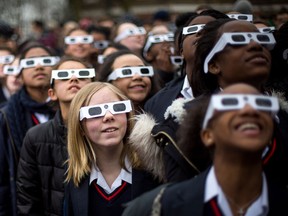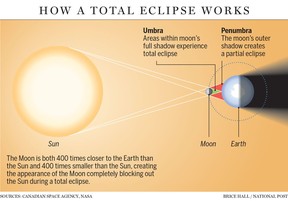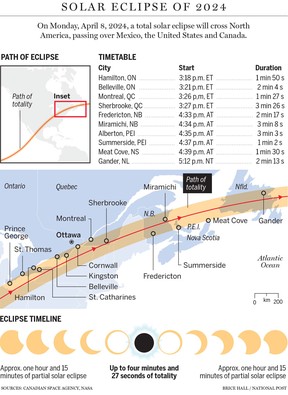Why you don't need to fear the total solar eclipse, as officials urge people to stay home
A lurch to the safest possible course, perhaps expected these days, comes at a cost and is at odds with other efforts pumping up the excitement of this rare event

Article content
A rare dark spot from a total solar eclipse will glide diagonally across North America on Monday, skirting the southern edge of Ontario and Quebec before sliding over the Atlantic provinces and out to sea, turning day into night for a few moments — and the response for some has been closing schools, declaring a state of emergency, and issuing alerts to stay indoors, not go to work, and draw the curtains.
This lurch to grasp the safest possible course — perhaps not unexpected these days — comes at a cost and is at odds with other efforts pumping up the excitement of such a rare phenomenon.
“Experiencing a total solar eclipse within the path of totality is one of the most awe-inspiring, immersive, and impactful nature experiences we can have,” said Kate Russo, a clinical psychologist and avid eclipse chaser.
“We should be inspiring our youth to explore and to experience the world — and what better experience is there than totality, when so much happens above you, around you, and within you.
“I think it would be a tragedy if people ignore the long-established safe methods of solar viewing and exclude children based upon their own fears,” she said.
For many in administration and governance, that sense of awe has been strangled by worry, hurling them into the comfort of safetyism, a policy of perseverating on perceived safety at all costs.
Ottawa-Carleton District School Board is closing all schools and cancelling all classes and activities for the entire day on April 8. Some parents greeted the announcement by asking if it was an April Fool’s joke.
Toronto District School Board, like several boards, shifted a professional development day from April 19 to April 8 so the schools could be closed for the eclipse.
It is due to “potential safety concerns,” the Toronto board said. Whether there are concerns or only that some concerns could potentially appear wasn’t addressed, but for information on the solar eclipse the board’s announcement didn’t point students and parents to the Canadian Space Agency, which declares “a spectacular and rare celestial event is set to unfold over Canada,” but rather to the Canadian Association of Optometrists.
York Region District School Board, north of Toronto, is sending all elementary and even secondary school students home early that day, and cancelling after-school activities.
“We have heard concerns regarding the potential for students being outside and inadvertently looking at the sun, which may cause serious health problems, such as loss of eyesight. We have also heard concerns of traffic and students walking home during peak darkness,” York’s board said.
Electronic highway signs by the Ontario Ministry of Transportation along the province’s major highways briefly warned people to stay home on the day of the eclipse: “Eclipse April 8: Skip Traffic: Telework,” the signs read. The government backtracked, removing the message and saying it had not been approved by leadership.
Some long-term care facilities and retirement homes plan to close all blinds on windows and are encouraging residents to remain in their rooms during the eclipse, including Perley and Rideau Health Centre in Ottawa, which cares for mostly military veterans.
Niagara lies close to the centre of the eclipse’s darkest path and with the already majestic scenery of Niagara Falls a huge crush of visitors is expected — more than a million — to view the eclipse there. The region has declared a state of emergency.
Much of Niagara’s fear has to do with the movement of many earthly bodies rather than three heavenly ones, but not only are Niagara’s schools cancelled, so are seniors’ programs, public health services, city hall and many other operations.
Focusing on fear rather than wonder and amazement, however, can keep people from having a rare, perhaps once-in-a-lifetime opportunity.
As the moon passes between the Earth and the sun, the moon casts a narrow shadow over us. The closer you are to the centre of the shadow the darker it will be. Most areas in Canada will experience a partial solar eclipse, with the moon only blocking a portion of the sun, but areas within a central 185-kilometre-wide strip, will experience the totality, when the moon entirely blocks the sun’s blazing surface.
Although the totality sounds like an existential threat in a Marvel movie, the darkness is brief, varying by location.
You can imagine the panic a solar eclipse brought in ancient times. We know a lot more about the sun these days, and about Earth, the moon and our eyes.
There is a danger of looking directly at the sun on any day and doing it can permanently damage vision.
The special worry during a solar eclipse is that something unusual is happening up there that attracts our attention and, when the sun’s face is only partially covered by the moon, its brilliance is muted, reducing the natural discomfort that normally pushes us to turn away.
“While these events are awe-inspiring, they also pose potential risks to eyesight if proper precautions are not taken,” according to the Canadian Association of Optometrists. “The danger lies in the fact that even during a partial eclipse, the sun’s intense radiation can cause severe damage to the eyes. Looking at the sun directly during an eclipse can lead to solar retinopathy, permanently damaging the retina’s light-sensitive cells.”
That’s where widely available eclipse safety glasses, common sense, and careful instruction to children come in, said Russo.
“If you’re using safe viewing methods, it is safe to experience. We need to give a little bit of education, you need to supervise young children — but actually, children understand this very well, it is common sense, so we don’t need to be fearful,” she said.
“We should all get into the path of totality if we can,” said Russo.
A partial solar eclipse should never be looked at without solar-standard eye protection. Regular sunglasses are not enough.
But those in the path of a total solar eclipse, for that fleeting period of totality, it can be looked at with the naked eye, according to Russo and NASA. The moon itself is the filter protecting eyes.
But be quick about it. The moments before and after the brief total phase, when the sun’s light is peeking out on one side or the other of the dark moon, can cause damage.
This will be Russo’s 14th total solar eclipse. She has experienced totality on six continents and this week travelled from her home in Australia to Texas for Monday’s. She studies the impact totality has on people.
“You notice the darkening of the sky coming towards you, but it’s not like a storm with dark atmospheric clouds,” she said. “You can see the sky darkening. It’s very eerie and it’s kind of frightening, in a way. You know something big is happening and even though you know intellectually what’s going to happen it still takes you by surprise. When it happens to you it is going to be so surprising and overwhelming and potentially emotional.”
The federal government, often ridiculed for overly cautious advice, seems big on the idea of enjoying this solar eclipse.
“An eclipse is a wonder to behold,” begins an article on the Government of Canada’s web page about the eclipse, below a redlined alert that looking directly at the sun without appropriate protection can lead to blindness.

Space experts at NASA and the Canadian Space Agency (CSA) get excited about celestial events, as much for the public interest and engagement they drive as for the event self.
NASA illustrates its solar eclipse web pages with photos of happy people, young and old, gathered outside staring up at the sky, all wearing eye protectors. CSA’s headline on its eclipse web page encourages Canadians to “grab your eclipse glasses and get ready to be amazed.”
CSA’s headquarters in Longueuil, Que., is in the path of totality. The advice it offers isn’t to stay indoors and draw tight the blinds. Its answer is to use safe solar viewing glasses and enjoy it.
“For young people, an event such as the April 8 total solar eclipse can be the start of a lifelong passion for space,” the CSA said. “This larger-than-life experience is a great moment to ponder our place in the cosmos.”
Although there is usually a solar eclipse somewhere on Earth every 18 months, seeing a totality in a specific location is usually a once-in-a-lifetime experience. NASA calculates an average of 366 years between total solar eclipses in any specific location.
• Email: ahumphreys@postmedia.com | X: AD_Humphreys



Postmedia is committed to maintaining a lively but civil forum for discussion. Please keep comments relevant and respectful. Comments may take up to an hour to appear on the site. You will receive an email if there is a reply to your comment, an update to a thread you follow or if a user you follow comments. Visit our Community Guidelines for more information.